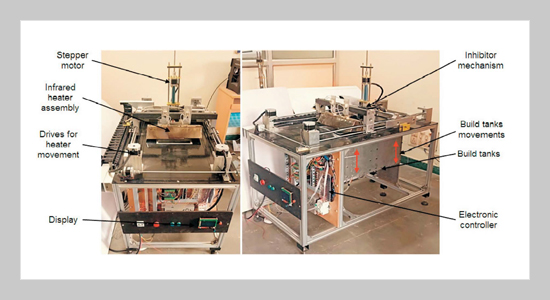REFERENCES
- [1] Khoshnevis, B., B. Asiabanpour, M. Mojdeh, and K. Palmer (2003) SIS–a new SFF method based on powder sintering, Rapid Prototyping Journal 9, 30�36. doi: 10.1108/13552540310455638
- [2] Asiabanpour, B. (2003) An Experimental Study of Factors Affecting the Selective Inhibition of Sintering Process, PhD Thesis, University of Southern California, California, p. 168.
- [3] Baraskar, S. S., S. S. Banwait, and S. C. Laroiya (2013) Multi objective optimization of electrical discharge machining process using a hybrid method, Materials and Manufacturing Processes 28, 348�354. doi: 10.1080/10426914.2012.700152
- [4] Sood, A. K., R. K. Ohdar, and S. S. Mahapatra (2009) Improving dimensional accuracy of fused deposition modelling processed parts using grey taguchi method, Materials and Design 30, 4243�4252. doi: 10.1016/ j.matdes.2009.04.030
- [5] Rajamani, D., E. Balasubramanian, P. Arunkumar, M. Silambarasan, and G. Bhuvaneshwaran (2018) Experimental investigations and parametric optimization of process parameters on shrinkage characteristics of selective inhibition sintered high density polyethylene parts, Experimental Techniques 42(6), 631�644. doi: 10.1007/s40799-018-0286-6
- [6] Negi, S., S. Dhiman, and R. K. Sharma (2015) Determining the effect of sintering conditions on mechanical properties of laser sintered glass filled polyamide parts using RSM, Measurement 68, 205�218. doi: 10. 1016/j.measurement.2015.02.057
- [7] Janaina, L. L., and G. V. Salmoria (2012) Microstructural characterization and mechanical properties of functionally graded PA12/HDPE parts by selective laser sintering, International Journal of Advanced Manufacturing Technology 59, 583�591. doi: 10.1007/ s00170-011-3538-5
- [8] Sood, A. K., A. Equbal, V. Toppo, R. K. Ohdar, and S. S. Mahapatra (2012) An investigation on sliding wear of FDM built parts, CIRP Journal of Manufacturing Science and Technology 5, 48�54. doi: 10.1016/j. cirpj.2011.08.003
- [9] Kumar, S. (2009) Sliding wear behavior of dedicated iron-based SLS materials, International Journal of Advanced Manufacturing Technology 43, 337�347. doi: 10.1007/s00170-008-1714-z
- [10] Sachdeva, A., S. Singh, and V. S. Sharma (2013) Investigating surface roughness of parts produced by SLS process, International Journal of Advanced Manufacturing Technology 64, 1505�1516. doi: 10.1007/ s00170-012-4118-z
- [11] Anitha, R., S. Arunachalam, and P. Radhakrishnan (2001) Critical parameters influencing the quality of prototypes in fused deposition modelling, Journal of Materials Processing Technology 118, 385�388. doi: 10.1016/S0924-0136(01)00980-3
- [12] Rajamani, D., A. Ziout, E. Balasubramanian, R. Velu, S. Salunkhe, and H. Mohamed (2018) Prediction and analysis of surface roughness in selective inhibition sintered high-density polyethylene parts: a parametric approach using response surface methodology–grey relational analysis, Advances in Mechanical Engineering 10(12). doi: 10.1177/16878 14018820994
- [13] Singh, V. S., S. Singh, A. Sachdeva, and P. Kumar (2015) Influence of sintering parameters on dynamic mechanical properties of selective laser sintered parts, International Journal of Materials Forming 8(1), 157� 166. doi: 10.1007/s12289-013-1158-3
- [14] Negi, S., and R. K. Sharma (2015) Influence of processing variables on dynamic mechanical response of laser-sintered glass-filled polyamide, Materials and Manufacturing Processes 30, 1431�1441. doi: 10. 1080/10426914.2014.994778
- [15] Asiabanpour,B.,K.Palmer,and B.Khoshnevis (2004) An experimental study of surface quality and dimensional accuracy for selective inhibition of sintering, Rapid Prototyping Journal 10(3), 181�192. doi: 10. 1108/13552540410539003
- [16] Asiabanpour, B., B. Khoshnevis, and K. Palmer (2006) Advancements in selective inhibition sintering process development, Virtual and Physical Prototyping 1(1), 43�52. doi: 10.1080/17452750500289 910
- [17] Aravind, A., P. Arunkumar, and E. Balasubramanian (2017) Comparative study of high performance polymers in selective inhibition sintering process through finite element analysis, Journal of Polymers and Polymer Composites 25(3), 199�202. doi: 10.1177/0967 39111702500303
- [18] Arunkumar, P., E. Balasubramanian, and U. Chandrasekhar (2017) Investigation on multi-layer selective inhibition sintering process using finite element analysis, Materials Today Proceedings 4(2), 2439�2444. doi: 10.1016/j.matpr.2017.02.095
- [19] Rajamani, D., and E. Balasubramanian (2017) Examining mechanical strength characteristics of selective inhibition sintered HDPE specimens using RSM and desirabilityapproach,IOPConferenceSeries:Materials Science and Engineering, 234, 012002. doi: 10.1088/ 1757-899X/234/1/012002
- [20] Balasubramanian, E., D. Rajamani, and P. Arunkumar (2018) Modeling and prediction of optimalprocess parameters in wear behaviour of selective inhibition sintered high density polyethylene parts, Progress in Additive Manufacturing 3(3), 109�121. doi: 10.1007/ s40964-017-0033-z
- [21] Ananthakumar, K., D. Rajamani, E. Balasubramanian, and J. Paulo Davim (2019) Measurement and optimization of multi-response characteristics in plasma arc cuttingofMonel400TM using RSMandTOPSIS, Measurement 135, 725�737. doi: 10.1016/j.measurement. 2018.12.010
- [22] Ogorkiewicz, R. M. (1970) Engineering Properties of Thermoplastics, Wiley & Sons Ltd.
- [23] Tamilarasan, A., and D. Rajamani (2017) Multi-response optimization of Nd: YAG laser cutting parameters of Ti-6Al-4V superalloy sheet, Journal of Mechanical Science and Technology 31(2), 813�821. doi: 10.1007/s12206-017-0133-1
- [24] Rajamani, D., K. Ananthakumar, E. Balasubramanian, and J. Paulo Davim (2018) Experimental investigation and optimization of PAC parameters on Monel 400TM superalloy, Materials and Manufacturing Processes 33(16), 1864�1873. doi: 10.1080/10426914.2018. 1532085









